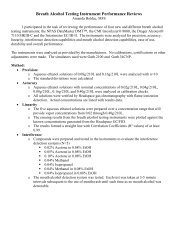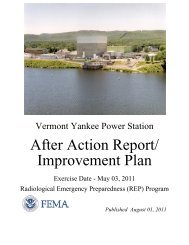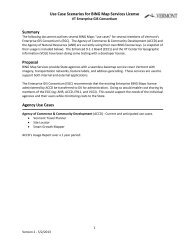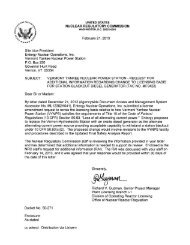AREVA NP Inc. ANP-3203Revision 0<strong>Vermont</strong> Yankee Nuclear Power Station’s Overall Integrated <strong>Plan</strong> in Response <strong>to</strong> March 12, 2012Commission Order Modifying Licenses with Regard <strong>to</strong> Requirements <strong>for</strong> <strong>Reliable</strong> HardenedContainment Vents (Order Number EA-12-050)Page 9ISG 1.1.2 Criteria:During a prolonged SBO. the drywell, wetwell (<strong>to</strong>rus), and nearby areas in the plant where HVCScomponents are expected <strong>to</strong> be located will likely experience an excursion in temperatures due <strong>to</strong>inadequate containment cooling combined with loss <strong>of</strong> normal and emergency building ventilation systems.In addition, installed normal and emergency lighting in the plant may not be available. Ucensees should takein<strong>to</strong> consideration plant conditions expected <strong>to</strong> be experienced during applicable beyond design basisexternal events when locating valves, instrument air supplies, and other components that will be required <strong>to</strong>safely operate the HCVS system. Components required <strong>for</strong> manual operation should be placed in areas thatare readily accessible <strong>to</strong> plant opera<strong>to</strong>rs, and not require additional actions, such as the installation <strong>of</strong>ladders or temporary scaffolding, <strong>to</strong> operate the system.When developing a design strategy, the <strong>NRC</strong> staff expects licensees <strong>to</strong> analyze potential plant conditionsand use its acquired knowledge <strong>of</strong> these areas, in terms <strong>of</strong> how temperatures would react <strong>to</strong> extended SBOconditions and the lighting that would be available during beyond design basis external events. Thisknowledge also provides an input <strong>to</strong> system operating procedures, training, the choice <strong>of</strong> protective clothing,required <strong>to</strong>ols and equipmen1. and portable lighting.Response (ref. ISG Item 1.1.2):The HCVS design allows initiating and then operating and moni<strong>to</strong>ring the HCVS <strong>from</strong> the MainControl Room and the backup remote control station in the diesel genera<strong>to</strong>r room, whichminimizes plant opera<strong>to</strong>rs’ exposure <strong>to</strong> adverse temperature and radiological conditions and theMain Control Room and diesel genera<strong>to</strong>r room, is protected <strong>from</strong> hazards assumed in NEI 12-06.Procedures will not require access <strong>to</strong> suppression pool (wetwell) area and exposure <strong>to</strong> extremeoccupational hazards <strong>for</strong> normal and backup operation <strong>of</strong> electrical and pneumatic systems.Connections <strong>for</strong> supplemental equipment needed <strong>for</strong> sustained operation will be located inaccessible areas protected <strong>from</strong> severe natural phenomena and minimize exposure <strong>to</strong>occupational hazards. Tools required <strong>for</strong> sustained operation, such as portable headlamps / orspecify lighting alternatives will be pre-staged, as necessary, in by NEI 12-06 defined s<strong>to</strong>ragelocations.Neither temporary ladders nor scaffold are required <strong>to</strong> access these connections or s<strong>to</strong>ragelocations.Requirement 1.1.3 -MinimizeRadiological ConseauencesThe HCVS shall also be designed <strong>to</strong> minimize radiological consequences that would impede personnelactions needed <strong>for</strong> event response.ISG 1.1.3 Criteria:The design <strong>of</strong> the HCVS should take in<strong>to</strong> consideration the radiological consequences resulting <strong>from</strong> theevent that could negatively impact event response, During the Fukushima event, personnel actions <strong>to</strong>manually operate the vent valves were impeded due <strong>to</strong> the location <strong>of</strong> the valves in the <strong>to</strong>rus moms. TheHCVS shall be designed <strong>to</strong> be placed in operation by opera<strong>to</strong>r actions at a control panel, located in the maincontrol room or in a remote location. The system shall be deigned <strong>to</strong> function in this mode with permanentlyinstalled equipment providing electrical power (e.g., dc power batteries) and valve motive <strong>for</strong>ce (e.g., N2/aircylinders). The system shall be designed <strong>to</strong> function in this mode <strong>for</strong> a minimum duration <strong>of</strong> 24 hours withno opera<strong>to</strong>r actions required or credited, other than the system initiating actions at the control panel.Durations <strong>of</strong> less than 24 hours will be considered ifjustified by adequate supporting in<strong>for</strong>mation <strong>from</strong> thelicensee. To ensure continued operation <strong>of</strong> the HCVS beyond 24 hours, licensees may credit manualactions such as moving portable equipment <strong>to</strong> supplement electrical power and valve motive powersources.
AREVA NP Inc. ANP-3203Revision 0<strong>Vermont</strong> Yankee Nuclear Power Station’s Overall Integrated <strong>Plan</strong> in Response <strong>to</strong> March 12, 2012Commission Order Modifying Licenses with Regard <strong>to</strong> Requirements <strong>for</strong> <strong>Reliable</strong> HardenedContainment Vents (Order Number EA-12-050)Page 10In response <strong>to</strong> Generic <strong>Letter</strong> (GL) 89-16, a number <strong>of</strong> facilities with MarkIcontainments installed ventvalves in the <strong>to</strong>rus ,oom, near the drywall, or both. Licensees can continue <strong>to</strong> use these venting locations orselect new locations, provided the requirements <strong>of</strong> this guidance document are satisfied. The HCVSimproves the chances <strong>of</strong> core cooling by removing heat <strong>from</strong> containment and Iowenng containmentpressure, when core cooling is provided by other systems. if core cooling were <strong>to</strong> fail and result in the onsetcore damage, closure <strong>of</strong> the vent valves may become necessary if the system was not designed <strong>for</strong> severeaccident service. In addition, leakage <strong>from</strong> the HCVS within the plant and the location <strong>of</strong> the external release<strong>from</strong> the HCVS could impact the event response <strong>from</strong> on-site opera<strong>to</strong>rs and <strong>of</strong>f-site help am ving at the plant.An adequate strategy <strong>to</strong> minimize radiological consequences that could impede personnel actions shouldinclude the following:1. Licensees shall provide permanent radiation shielding where necessary <strong>to</strong> facilitate personnel access <strong>to</strong>valves and allow manual operation <strong>of</strong> the valves locally. Licensee may use alternatives such as providingfeatures <strong>to</strong> facilitate manual operation <strong>of</strong> valves <strong>from</strong> remote locations, as discussed further in this guidanceunder Requirement 1.2.2, or relocate the vent valves <strong>to</strong> areas that are significantly less challenging <strong>to</strong>opera<strong>to</strong>r access/actions.2. In accordance with Requirement 1.2.8, the HCVS shall be designed <strong>for</strong> pressures that are consistent withthe higher <strong>of</strong> the primary containment design pressure and the primary containment pressure limit (PCPL),as well as including dynamic loading resulting <strong>from</strong> system actuation. In addition, the system shall be leaktight.As such, ventilation duct work (i.e., sheet metal) shall not be utilized in the design <strong>of</strong> the HCVS.Licensees should per<strong>for</strong>m appropriate testing, such as hydrostatic or pneumatic testing, <strong>to</strong> establish theleak-tightness <strong>of</strong> the HCVS,3. The HCVS release <strong>to</strong> outside atmosphere shall be at an elevation higher than adjacent plant structures.Release through existing plant stacks is considered acceptable, provided the guidance under Requirement1.2.6 is satisfied. If the release <strong>from</strong> HCVS is through a vent stack different than the plant stack theelevation <strong>of</strong> the stack should be higher than the nearest building or structure.Response (ref. ISG Item 1.1.3):The HCVS will be designed <strong>for</strong> reliable remote-manual operation. Opera<strong>to</strong>rs will not be required<strong>to</strong> access the suppression pool area. The HCVS will be designed <strong>to</strong> minimize system crossflow, prevent steam flow in<strong>to</strong> unintended areas, provide containment isolation, and providereliable and rugged per<strong>for</strong>mance as discussed below <strong>for</strong> Order requirements 1.2.6.Dose rates are evaluated consistent with the assumption that the HCVS is <strong>to</strong> be used <strong>for</strong> theprevention <strong>of</strong> core damage. Shielding or other alternatives <strong>to</strong> facilitate manual actions are notrequired <strong>for</strong> operation <strong>of</strong> the vent under these conditions since no core damage has occurred.






